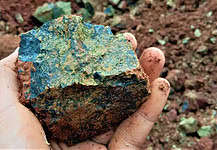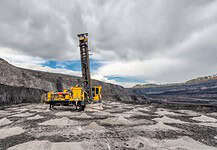GLENCORE announced its decision to cap coal production at current levels after heavy pressure from investor signatories of the Climate Action 100+ initiative – but the global miner remains comfortably set with its Australian assets to cater for an expected increase in coal demand.
Glencore is Australia’s largest thermal coal producer with more than 75 million tonnes of coal produced by the company’s Australian assets annually.
In 2018, Glencore acquired 49 per cent of Rio Tinto’s Hunter Valley Operations (HVO), an 82 per cent share of the Hail Creek coal mine and 71.2 per cent of the greenfields Valeria coal project.
The acquisitions confirmed the company’s commitment to Australia’s coal industry just months before it announced it would cap coal production globally after pressure from investor signatories of the Climate Action 100+ initiative.
The company released a statement on 20 February detailing the steps it would take, and in the Preliminary Results 2018 Report, confirmed it had a key role to play in enabling the transition to a low carbon economy.
“We aim to prioritise capital investment to grow production of commodities essential to the energy and mobility transition and to limit our coal production capacity broadly to current levels,” the report stated.
“Our commitments include: Paris-consistent capital discipline, developing new longer-term Scope 1 and 2 reduction targets, regular review of progress, alignment with TCFD recommendations and corporate climate change lobbying review.
“We believe this transition is a key part of the global response to the increasing risks posed by climate change, which must pursue the twin objectives of both limiting temperatures in line with the goals of the Paris Agreement and supporting the United Nations Sustainable Development Goals, including universal access to affordable energy.”
In 2018, Glencore produced 129.4 million tonnes of coal from its 26 coal mine assets across Australia, Colombia and South Africa; of which 94.4 million tonnes of thermal coal was sold.
The company’s operations currently had capacity for 150 million tonnes of coal and it has agreed not to increase tonnage of thermal coal produced by the group on a future basis.
And Glencore was well positioned to make the transition through its portfolio in cobalt, nickel, copper, vanadium and zinc – all commodities that underpinned energy and mobility transformation.
“Our commodity portfolio and its key role in enabling the energy and mobility transition for a low-carbon economy enables us to look ahead with confidence and to remain focussed on creating sustainable long-term value for all our shareholders,” Glencore chief executive Ivan Glasenberg said.
Glencore would also take steps to reduce its greenhouse gas emission intensity by five per cent by 2020 (compared to a 2016 baseline), and allow public access to annual reports of its progress towards meeting climate change objectives, as well as re-assess whether its membership in relevant trade organisations might undermine its support for the Paris Agreement and goals.
Minerals Council of Australia chief executive Tanya Constable agreed that there was a need to minimise the cost of meeting Australia’s international emission reduction targets.
Ms Constable cited the BAEconomics’ peer-reviewed modelling, which showed how the use of international offsets along with carry-over of earlier Kyoto-period overachievement would significantly reduce the cost of meeting emissions reduction targets.
“Addressing climate change is not easy, particularly for a major energy and resource-intensive country like Australia, which needs a diverse future energy mix that balances affordability, reliability and emissions reduction,” Ms Constable said.
“This is why a measured response is critical to reducing greenhouse emissions in a way, which does not damage the economy, destroy jobs and hurt Australian businesses and families.
“Using credible and verifiable international offsets along with carry-over of emission reductions from the first and second Kyoto commitment periods will be central to Australia implementing a measured response.”
Australian Outlook
According to the International Energy Agency, the elimination of coal-fired generation is a key climate policy goal in some countries, while in others, coal is abundant and affordable and remains the key source of electricity.
In Australia, the coal market was proving resistant to change, which bodes well for Glencore’s bottom line – regardless of a coal cap.
The Indian economy was expected to grow more than 8 per cent a year to 2023 and with the electrification process continuing, power demand was forecast to rise by more than 5 per cent per year over the period.
In Glencore’s Full Year 2018 production report, Mr Glasenberg indicated Australian coal could supply this market.
“Indian and Chinese thermal electricity demand growth was 4.9 per cent and 6.0 per cent [in 2018] respectively, supporting demand growth for imported thermal coal,” Mr Glasenberg said.
“In Asia-Pacific markets, excluding China and India, import demand was buoyed by 8.9GW of newly commissioned coal fired power stations to meet demand for low cost base load electricity.
“More than 50GW of new coal fired generation capacity is currently under construction in the region.”
Mr Glasenberg also cited the increase in global steel production to 4.7 per cent in 2018, with 73 per cent of steel being produced via blast furnace using coking coal.
“Globally, pig iron production from blast furnaces increased by 1.5 per cent in the seaborne import markets, excluding China. Australian supply recovered to meet the coking coal demand growth,” he said.
“While most commodities ended the year materially lower than where they started, thermal coal was broadly unchanged, as demand for high-quality coals remained robust against a backdrop of limited reinvestment in supply.”
Subsequently, Glencore’s coal production outlook for 2019 remained high with a production guidance increase to about 145 million tonnes globally – reflecting a full year’s contribution from Australian assets HVO and Hail Creek plus business improvement initiatives at existing operations.
The company had already identified some $185 million of managed annual cost savings/margin improvements to be realised upon completion of the restructure plans at both HVO and Hail Creek.
It remains to be seen just how important a role these low-cost, high-quality assets will play in Glencore’s Australian operations in the years to come but the company has cleverly positioned itself positively in the debate around energy and climate change, soothing the ruffled feathers of investors while simultaneously maintaining its grip on the Australian coal market.








































